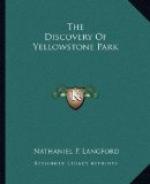“After much toil he reached the summit of a lofty cliff, but it was only to behold gigantic peaks rising all around, and towering far into the snowy regions of the atmosphere. He soon found that he had undertaken a tremendous task; but the pride of man is never more obstinate than when climbing mountains. The ascent was so steep and rugged that he and his companion were frequently obliged to clamber on hands and knees, with their guns slung upon their backs. Frequently, exhausted with fatigue and dripping with perspiration, they threw themselves upon the snow, and took handfuls of it to allay their parching thirst. At one place they even stripped off their coats and hung them upon the bushes, and thus lightly clad proceeded to scramble over these eternal snows. As they ascended still higher there were cool breezes that refreshed and braced them, and, springing with new ardor to their task, they at length attained the summit.”]
[Footnote P: Soon after the return of our party to Helena, General Washburn, then surveyor-general of Montana, made in his office for the Interior Department at Washington, a map of the Yellowstone region, a copy of which he gave to me. He told me that in recognition of the assistance I had rendered him in making a fair outline of Yellowstone lake, with its indented shore and promontories, he had named for me the mountain on the top of which I stood when I made the sketch of the south shore of the lake. I called his attention to the fact that Lieutenant Doane had been my comrade in making the ascent, and suggested that Doane’s name be given to the adjoining peak on the north. He approved of this suggestion, and the map, with these mountains so named, was transmitted to the Interior Department.
Dr. Hayden, the geologist in charge of the United States geological survey, made his first visit to this region the following year (1871), and on the map which he issued in connection with his 1871 report, the name “Mount Langford” was given to another mountain far to the northeast. Since that time my name has again been transferred to a mountain on the southeast. I think that Dr. Hayden must have been aware at that time that this mountain bore my name; for he had read the account of the Washburn exploration, which was published in Scribner’s Magazine for May, 1871, accompanied by a copy of the map made by General Washburn.
The significance of connecting my name with this mountain is centered in the circumstance that it was intended to mark or commemorate an important event—that of giving to the public a very correct outline map of Yellowstone lake. In confirmation of the fact that the first outline of the lake approximating any degree of accuracy was made from the mountain-top, I here quote from page 21 of Lieutenant Doane’s report to the War Department.
“The view from this peak commanded completely the lake, enabling us to sketch a map of its inlets and bearings with considerable accuracy.”




